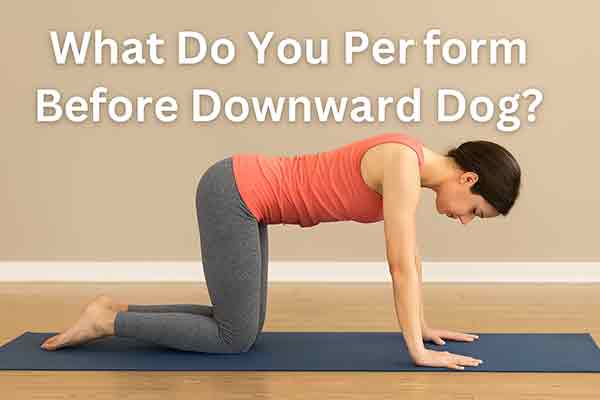What Do You Perform Before Downward Dog? | Prepping for Adho Mukha Svanasana
Table of Contents
- Introduction
- Understanding Downward Dog (Adho Mukha Svanasana)
- Why Warming Up Before Downward Dog Matters
- Essential Yoga Poses to Perform Before Downward Dog
- A Sample Yoga Flow to Prepare for Downward Dog
- Modifications and Tips for Beginners
- Common Mistakes to Avoid Before Entering Downward Dog
- Breath Awareness in Your Prep Practice
- Conclusion
Introduction
Downward Dog, or Adho Mukha Svanasana, is one of the most recognized yoga poses. Often used as a transitional posture or resting point, it’s far from passive. To fully benefit from this dynamic stretch, it’s crucial to ask: What do you perform before Downward Dog? This article will explore the best warm-up poses, preparatory stretches, and mindful techniques to ease your body into Downward Dog safely and effectively.
Understanding Downward Dog (Adho Mukha Svanasana)
Downward Dog is a foundational pose that stretches the hamstrings, calves, shoulders, and spine. It also strengthens the arms and legs, promotes circulation, and acts as a reset during your yoga sequence. However, without proper preparation, you might strain your wrists, overstretch your back, or miss the alignment benefits.
Why Warming Up Before Downward Dog Matters
Jumping straight into Downward Dog can be jarring—especially if your body isn’t warm. Here’s why warm-ups are important:
- Increases blood flow: Warming up delivers oxygen to muscles, preventing injury.
- Improves flexibility: Tight hamstrings and shoulders need gentle coaxing before stretching.
- Enhances joint mobility: Lubricating joints helps with shoulder rotation and hip hinge.
- Builds awareness: Prepping poses help you become attuned to alignment and breath.
Essential Yoga Poses to Perform Before Downward Dog
Here are foundational poses and movements that prime your body for Downward Dog:
1. Cat-Cow (Marjaryasana-Bitilasana)
Warms up the spine and shoulders while enhancing breath coordination.
2. Child’s Pose (Balasana)
Gently opens the back, hips, and shoulders. A good pose to check in with your breath.
3. Tabletop Position
A great starting point for transitions. Helps align wrists, shoulders, and knees.
4. Low Lunge (Anjaneyasana)
Opens the hip flexors and quads, reducing tension that could affect Downward Dog alignment.
5. Standing Forward Fold (Uttanasana)
Stretches the hamstrings and calves while gently decompressing the spine.
6. Plank Pose
Activates the core and shoulders, building strength for Downward Dog transitions.
7. Puppy Pose (Uttana Shishosana)
Targets the shoulders and spine while keeping the hips elevated—perfect for preparing the back line of the body.
A Sample Yoga Flow to Prepare for Downward Dog
Here’s a short warm-up sequence that takes 5–10 minutes and leads naturally into Downward Dog:
- Start in Child’s Pose – 5 breaths
- Move to Tabletop, then flow through 5 rounds of Cat-Cow
- Transition to Puppy Pose – hold for 5 breaths
- Step one leg forward into Low Lunge – 5 breaths each side
- Come into Standing Forward Fold – 5 breaths
- Step back into Plank Pose – hold for 3–5 breaths
- Gently shift into your first Downward Dog
This flow wakes up the full body while keeping breath and alignment in focus.
Modifications and Tips for Beginners
- Bend the knees: Don’t worry about having straight legs in Downward Dog if your hamstrings are tight.
- Use blocks: Support your hands in forward folds or low lunges for better alignment.
- Shorten your stance: Bringing feet slightly closer to hands helps reduce wrist and shoulder strain.
- Focus on breath: Let the breath guide your movement and pacing.
Common Mistakes to Avoid Before Entering Downward Dog
- Skipping warm-ups: Cold muscles are more likely to strain or cramp.
- Locking joints: Keep a slight micro-bend in elbows and knees for joint safety.
- Overreaching: Focus on lengthening the spine, not pushing heels to the ground.
- Forgetting the core: Engaging the core supports the lower back.
Breath Awareness in Your Prep Practice
Breath is central to yoga. Before entering Downward Dog, use each preparatory pose as a way to connect breath to movement. Inhale to lengthen, exhale to deepen. Coordinating your breath not only calms the mind but helps prevent injuries and enhances pose effectiveness.
Conclusion
So, what do you perform before Downward Dog? Think of it as a sequence of mindful movements that gradually awaken your spine, hamstrings, shoulders, and breath. Whether you’re a beginner yogi or a seasoned practitioner, setting a solid foundation with gentle warm-ups will improve your alignment, reduce discomfort, and make Downward Dog a truly rejuvenating pose.
Looking for more yoga sequencing tips and pose breakdowns? Explore our blog for complete flows, tutorials, and mindful practice guides to elevate your time on the mat.







